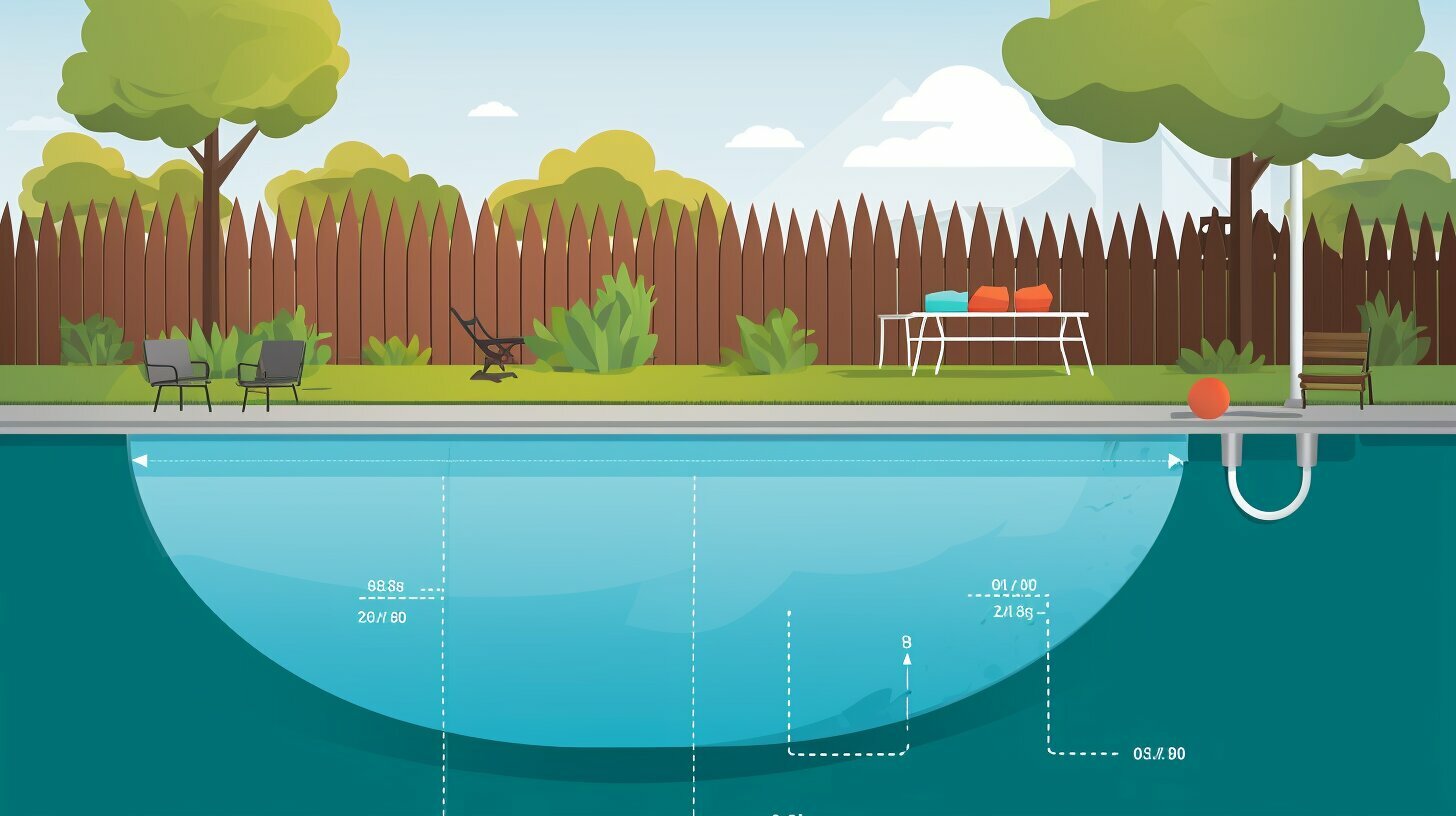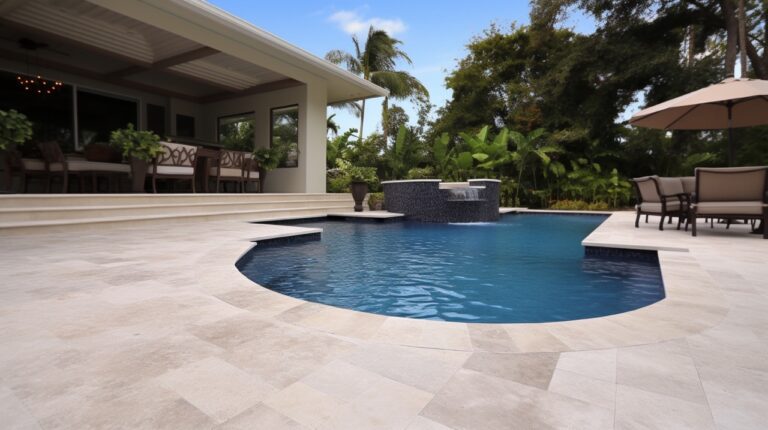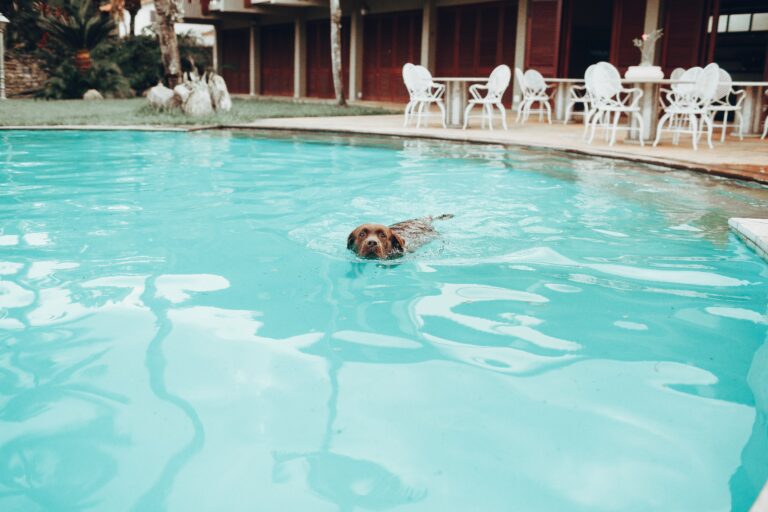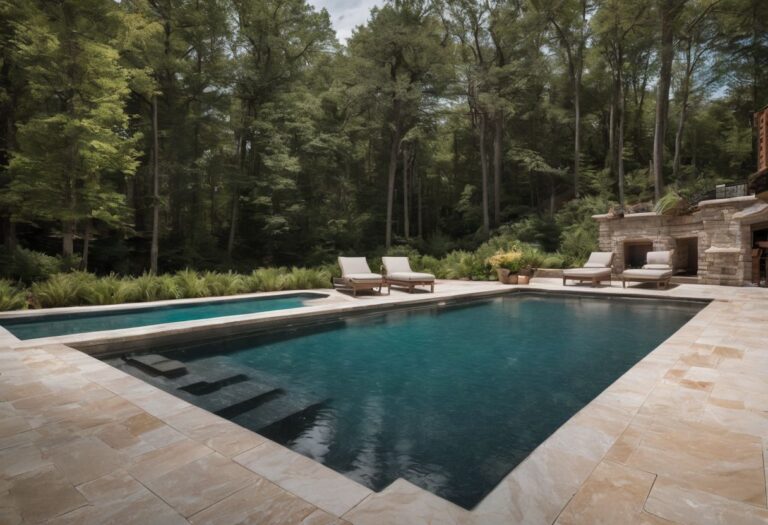How Deep Can a Backyard Pool Be? What to Know 2023
How deep can a backyard pool be? Let’s look at the ideal depth for your backyard pool. Whether you’re considering a new pool or want to make the most of your current one, it’s crucial to understand pool depth and its importance for safety and enjoyment.
When building a vinyl liner pool (one of the most popular) you’re typically limited by the pool kit size, budget, soil conditions. If the dimensions of the pool are too small, you won’t be able to achieve as much depth due to the slope of the pool. For our DIY project, 20×40 ft pool we opted for a 9 ft deep and and a 3′ 10″ shallow end, which is slightly deeper than standard.
How Deep Can a Backyard Pool Be? the Importance of Pool Depth
When designing a backyard pool, it’s important to consider the depth of the water carefully. The depth of your pool will determine the level of safety and enjoyment you and your guests experience as they swim and play in the water. Understanding the significance of pool depth is crucial to creating a safe and optimal environment.
Pool depth is measuring the water from the surface to the pool’s floor. The ideal depth of a pool can vary depending on factors such as the size of the pool, its shape, and its intended use. Generally, deeper water is better for diving, while shallower water is ideal for children and non-swimmers.
Regarding pool depth, it’s essential to consider the different areas within the pool, such as the shallow and deep ends. The shallow end is typically around three to four feet deep, making it ideal for children to enjoy the water safely. The pool’s deep end, on the other hand, can range from seven to twelve feet deep, providing enough depth for diving and other activities.
The ideal pool depth is the one that meets the needs of all of its users. Therefore, it’s best to combine shallow and deep areas to ensure maximum safety and enjoyment. This way, children and non-swimmers can use the shallow end, while experienced swimmers and divers can enjoy the deep end.

Ultimately, the depth of your pool is a crucial factor in its design. Whether building a new pool or revamping an existing one, it’s important to consider the ideal depth for your needs. Working with a reputable pool builder can help ensure your pool is safe, practical, and enjoyable.
Minimum and Maximum Pool Depths for Safety
Safety should always be a top priority when considering the right depth for your backyard pool. The appropriate depth depends on several factors, including the age and swimming ability of the users.
The minimum depth for a pool should be no less than three feet, which is the recommended depth for safe standing and walking in the shallow end. For diving, the minimum depth should be at least nine feet to prevent injuries. However, it’s important to note that diving should only be done in designated areas with appropriate safety measures. If your pool is not deep enough for diving, avoid using diving boards or other devices that encourage diving.
The maximum depth of a pool is typically around six or eight feet, mostly since pools deeper than that require more water to fill and are more costly to maintain. Moreover, extra caution should be taken with pools deeper than six feet to avoid the risks of drowning, especially with young children or inexperienced swimmers. For these reasons, consulting with a pool builder who can guide you through the best depth options for your specific needs is crucial.
Remember that pool depth is not the only factor to consider for safety. Other measures, such as fencing, alarms, and supervision, are also essential to prevent accidents and ensure a safe and enjoyable swimming experience.
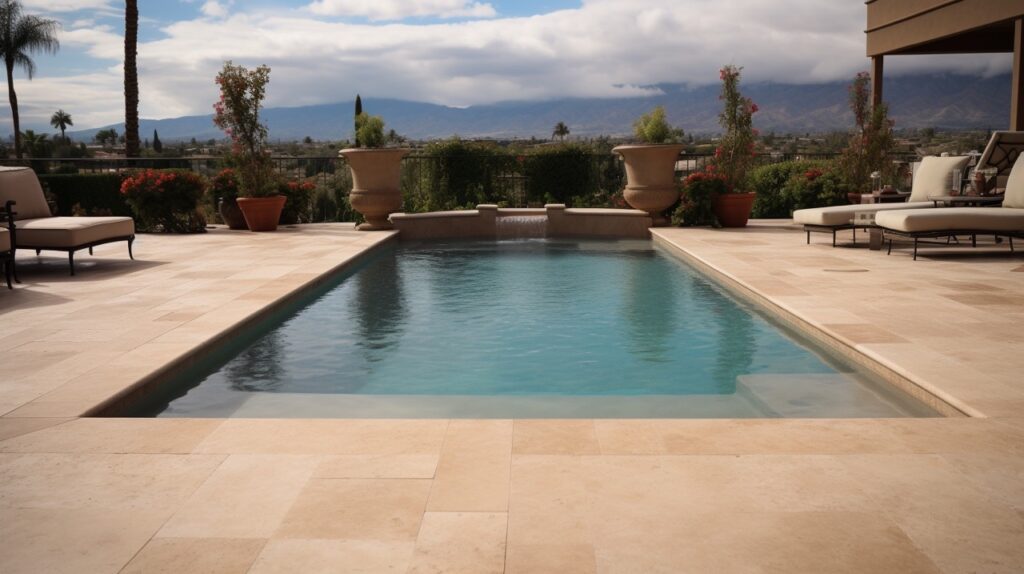
Different Shapes and Sizes of Backyard Pools
When choosing the shape and size of your backyard pool, various options are available. The size and shape of your pool will affect its depth, and it’s crucial to consider these factors when planning your pool to ensure you achieve the desired depth.
One popular option for those with limited space is a small inground pool. These pools are perfect for those who want to enjoy the benefits of a pool without a large footprint. They are available in various shapes, such as square, rectangular, and circular, with customizable depth options to fit your preferences.
You may consider a larger or L-shaped pool if you have more significant space. These designs provide ample space for swimming and relaxation, with various depth options available to cater to your needs. A larger pool offers the advantage of increased depth, allowing for diving and other water activities that require more significant water depth.
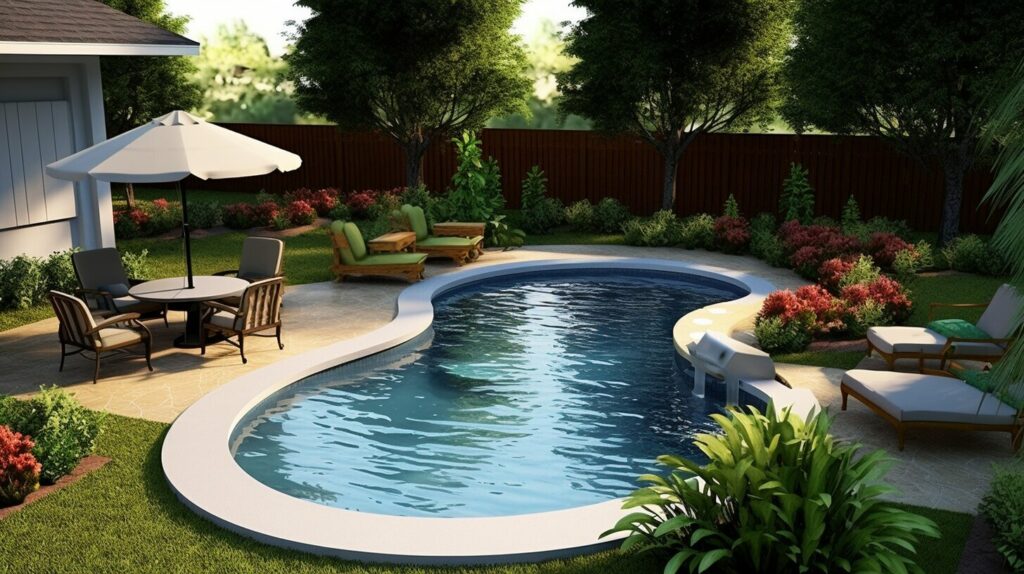
Tip: When selecting the shape and size of your pool, consider the available space in your backyard and the intended use of the pool. A smaller pool may suffice for relaxation and exercise purposes, while a larger pool may be necessary for recreational activities.
Advantages and Limitations of Different Shapes
The shape of your pool affects its depth and ease of maintenance. A rectangular pool, for example, provides more space for swimming and water games, while a circular pool may be more suitable for relaxation and aesthetic purposes. Other shapes, such as freeform or kidney-shaped pools, provide a unique design aesthetic but may limit the depth of the pool.
| Shape | Advantages | Limitations |
|---|---|---|
| Rectangular | Ample space for swimming and water games | Plainer design |
| Circular | Aesthetic appeal and relaxing atmosphere | May have a limited space for swimming and water games |
| Freeform | Unique design aesthetic | May limit the depth of the pool |
Ultimately, the shape and size of your pool depend on your preferences and available space. Consider the advantages and limitations of each shape when selecting the design for your backyard pool.
Factors Influencing Pool Depth
When planning a backyard pool, several factors come into play when determining the ideal depth. Your pool’s shape, the available outdoor space, the square footage, and the expertise of the pool builder are key considerations that can influence pool depth.
The shape of your pool is an important factor as it determines the depth in various areas. For instance, a rectangular pool typically has a shallow and deep end, while a round pool is more uniformly deep. An experienced pool builder can help you determine the best shape for your space and desired depth.
The amount of available outdoor space can also impact pool depth. If your backyard is limited, a smaller pool with a depth that can accommodate various activities may be ideal. A deeper pool with more square footage may be possible for larger outdoor spaces.
When choosing the right depth, the pool builder’s expertise is vital. A skilled pool builder will consider the intended use of the pool and recommend the ideal depth for safety and maximum enjoyment.
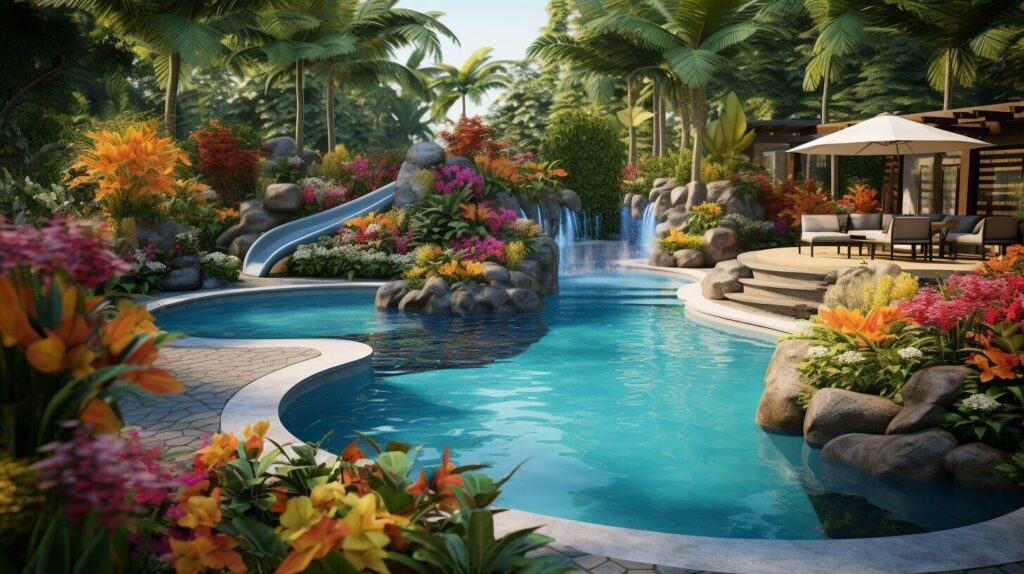
Ultimately, the ideal pool depth depends on your intended use of the pool and who will be using it. Considering these factors, you can ensure your pool is safe and enjoyable.
Deep Pools for Diving Enthusiasts
If you’re a fan of diving, you likely dream of having a pool that meets your needs. Deep pools are essential for diving and must be carefully constructed to ensure safety and enjoyment. Diving pools should generally have a minimum depth of 8 feet, but the ideal depth may vary depending on different factors.
It’s essential to consider the type of diving you’ll be doing in your pool. For example, if you plan on springboard diving, you’ll need a pool with a smaller surface area than if you do platform diving.
The type of diving board you use will also impact the depth of your pool. For example, if you’re using a diving board with a 1-meter springboard, you’ll need a pool at least 11.5 feet deep. If you’re using a 3-meter springboard, your pool should be at least 12.5 feet deep.

Safety Measures for Shallow Water and Young Children
Creating a safe swimming environment for young children is crucial when owning a backyard pool. The pool’s shallow end is an important safety feature for small and young toddlers. It is recommended to have a shallow end of at least 3 feet deep.
While a 3-foot depth may seem safe, it is important to note that children of different ages and swimming abilities may require different water depths. For instance, small children who cannot swim well require a shallower pool to prevent accidents.
It’s important to utilize safety features like pool safety fences, covers, and gates to prevent accidental drowning. A pool alarm can also help alert you if someone enters the pool unattended. Additionally, it’s essential to always supervise children in or near the pool.
Remember to teach young children basic water safety, such as never entering the pool without adult supervision, not running around the pool area, and not diving into shallow water.
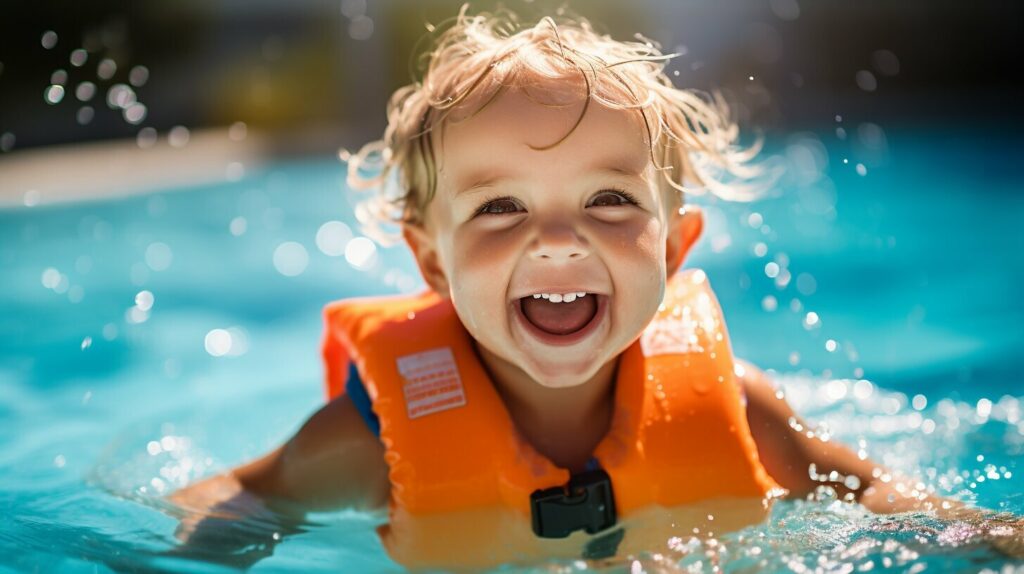
Multi-Depth Pools for Versatility
A multi-depth pool is a great way to cater to different needs and preferences. These pools typically feature a shallow end for leisure activities and a deeper area for swimming and diving.
One advantage of multi-depth pools is their versatility. They can accommodate users with varying swimming abilities, making them ideal for families with children of all ages. Kids can safely enjoy the shallow end while adults can swim laps or dive in the deep end.
Multi-depth pools also offer the flexibility to host various activities and events. From pool parties with friends to practicing swimming techniques, these pools provide ample space and depth to cater to any activity.
Pool builders can customize multi-depth pools to fit any outdoor space or personal style preference. Whether you have a small backyard or a larger outdoor area, there are multi-depth pool options to suit your needs.
Designing a Multi-Depth Pool
When designing a multi-depth pool, it’s essential to consider the depth of each area. The shallow end is typically between 3-5 feet deep, while the deep end can range from 6-12 feet, depending on the pool’s overall size and shape.
It’s also important to ensure proper safety measures are in place. Use fencing, pool covers, or other safety barriers to prevent accidents and keep young children away from the deep end.
To get the most out of your multi-depth pool, consider adding features like underwater benches or ledges for resting and relaxation.

With a multi-depth pool, you can enjoy the best of both worlds and create a pool that caters to your unique needs. From swimming laps to playing games with the family, a multi-depth pool offers the versatility and flexibility to make every swim great.
Lap Pools: The Right Depth for Swimmers
Lap pools are popular for those looking to improve their swimming skills or stay fit. To get the most out of a lap pool, having the right depth is essential.
The ideal depth for a lap pool is typically between 4 and 5 feet, allowing swimmers to maintain a consistent stroke and kick without constantly touching the bottom of the pool. The depth should be uniform throughout the pool, without any sudden drops or changes in depth that could cause injury.
When planning a lap pool, it’s crucial to consider your personal swimming needs and the intended use of the pool. Some swimmers may prefer a deeper pool for diving or practicing other advanced techniques, while others may benefit from a shallower pool for easier water aerobics or rehabilitation exercises.
A lap pool with the right depth can also provide significant health benefits. Swimming is a low-impact exercise that improves cardiovascular health, increases muscle tone, and reduces stress. With a lap pool designed to the proper depth, swimmers can achieve their fitness goals and enjoy a safe and enjoyable swimming experience.

Whether you’re a competitive swimmer or looking for a low-impact way to stay active, a lap pool with the right depth can be an excellent investment in your health and wellness. Consider consulting with a pool builder to determine the optimal depth for your needs and get started on building the pool of your dreams.
Choosing the Right Pool Depth for Recreational Purposes
Regarding recreational activities in the pool, such as pool games, playtime, and other water activities, it’s essential to consider the right pool depth. Having the right depth ensures the safety of everyone using the pool, particularly young children and those who are not strong swimmers.
The depth of your pool will depend on the activities you plan to do. For instance, if you want to enjoy pool games, consider a pool depth ranging from 4 to 5 feet. This range provides ample space for games like volleyball, basketball, or pool noodles. It also allows swimmers to stand comfortably, increasing the game’s safety.
If you plan to incorporate playtime for kids, a pool depth ranging from 3 to 4 feet is ideal. This depth allows for swimming and play but allows younger children to stand comfortably and play around without drowning.
Opt for a deeper pool if you’re considering water games or other activities requiring more depth. A depth of 8 feet is ideal for diving or simply jumping into the pool. However, it’s crucial to ensure all safety measures are in place for activities such as diving, including using a diving board and proper training.

Overall, finding the right pool depth for recreational purposes is crucial for everyone’s safety. When deciding the pool depth, consider the activities you plan to do, the swimming abilities of the users, and any safety measures necessary for certain activities. With the right pool depth, you can ensure a fun and safe environment for all pool users.
FAQ
What is the ideal depth for a backyard pool?
Ideal pool depth varies based on purpose, the swimmers’ age, and swimming skills. Usually, a shallow end with a depth of around 3-4 feet and a deeper end up to 8-9 feet is recommended. This configuration facilitates safe swimming and diving for all ages.
Does the shape of the pool influence its depth?
Yes, pool shape can impact the pool’s depth. Some pool designs, like rectangular or kidney-shaped pools, naturally lend themselves to having varying depths, with a shallow and a deeper end.
Can fiberglass pools have greater depths compared to other types of pools?
Yes, fiberglass in-ground pools can be deeper than other pool types, depending on the manufacturer. But remember, deeper pools may require more maintenance and increase installation costs.
How does my yard’s square footage affect my pool’s depth and size?
Your yard’s size limits both the size and depth of your pool. A bigger pool will require more yard space. If you’re restricted in space, a swim spa might be the best choice, offering the benefits of a small pool and a hot tub in a compact area.
Are there any safety concerns with deeper pools?
Deep pools can pose safety concerns, especially if you’re considering diving or have poor swimmers in the family. Always ensure proper safety measures, like a diving board and visible pool depth signage. Also, consider a traditional ladder or other easy ways to exit the deep waters.
What is the average depth of most residential pools?
The average depth of residential pools typically ranges between 3 and 8 feet. The perfect size will depend on the purpose of your pool – if it’s a play pool for kids, a shallow pool or a separate wading pool would be a safe height and the best option.
Can beach balls and other pool accessories be used in deeper pools?
Yes, beach balls and other pool accessories can be used in deeper pools. Just ensure these do not obstruct visibility or pose hazards to swimmers, especially in the deeper end.
How does pool depth influence costs?
Deeper depths can raise costs due to the extra volume of water and increased excavation work. You may also find a greater need for safety features in deeper pools, which could be an additional cost.
Can pool accessories like water slides be installed in deeper pools?
Yes, accessories like water slides can be added to deeper pools. However, specific safety guidelines should be followed regarding their placement and the water depth at their end.
Does the bottom of the pool need to be flat?
Not necessarily. Some pool owners prefer a sloping bottom, especially larger pools with varying depths. The design process should consider this aspect.
Ultimately, the depth of your swimming pool depends on its intended use, the swimmers’ abilities, your backyard space, and your budget. Consult a professional pool builder to ensure your dream pool fits your needs and safety considerations.
